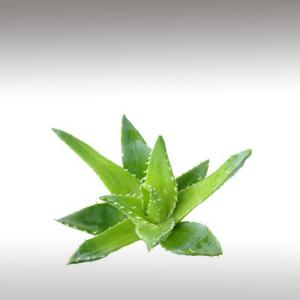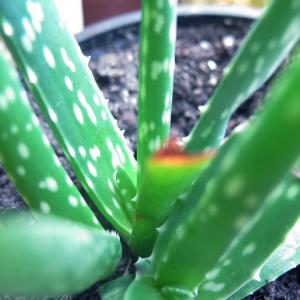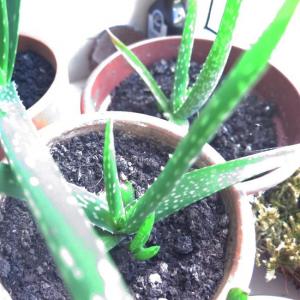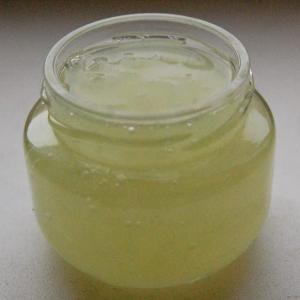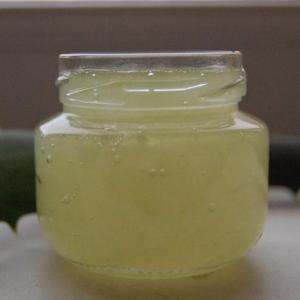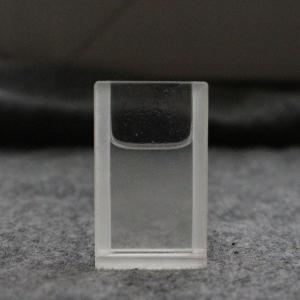
ALOE VERA (ALOE BARBADENSIS) - INGREDIENTS

BASE / GENERAL DATA
Information submited: March 14, 2014 Modified: May 18, 2018 By: OperaDreamhouse
Aloe Vera is a succulent plant species that is found only in cultivation, having no naturally occurring populations, although closely related aloes do occur in northern Africa.
The species is frequently cited as being used in herbal medicine since the beginning of the first century AD. Extracts from Aloe Vera are widely used in the cosmetics and alternative medicine industries, being marketed as variously having rejuvenating, healing, or soothing properties.
The leaves are thick and fleshy, green to grey-green, with some varieties showing white flecks on their upper and lower stem surfaces. The margin of the leaf is serrated and has small white teeth. Plant is growing in temperate and tropical regions of Australia, Barbados, Belize, Nigeria, Paraguay, Mexico and the US States of Florida, Arizona and Texas.
Aloe has a nauseating bitter taste, rendering it unusable in cooking, but this very property protects it in the wild as animals will move on to tastier treats. It is an easy plant to grow and requires little care other than protecting it from frost.
6000 year old stone carvings in Egypt contain images of the plant, which they referred to as the "Plant of Immortality". It was given as a burial gift to deceased pharaohs.
The virtues of Aloe Vera have been recorded for thousands of years by many ancient civilizations, including Egypt, Persia, Greece, India and Africa. The name was derived from the Arabic alloeh meaning "Bitter" because of the bitter liquid found in the leaves. It is also known as "Lily of the Desert", the "Plant of Immortality", and the "Medicine Plant".
Aloe Vera is used in traditional medicine as a multipurpose skin treatment. In Ayurvedic medicine it is called "Kathalai". Early records of Aloe Vera use appear in the Ebers Papyrus from the 16th century BC. It is also written of in the Juliana Anicia Codex of 512 AD.
Preparations made from Aloe Vera are often referred to as "Aloe Vera". Scientific evidence for the cosmetic and therapeutic effectiveness of aloe vera is limited and when present is frequently.
Chemical structure:
Although Aloe is about 99% water, the remaining 1% is extremely powerful and it is thought this is because the close to 100 ingredients work extremely well together (synergistically).
Aloe Vera contains many minerals vital to the growth process and healthy function of all the body's systems. The ingredients in Aloe can be grouped into the following categories: Vitamins, minerals, sugars, enzymes, lignins, amino acids, anthraquinones, saponins, fatty acids, salicylic acid.
Aloe vera contains:
Aloe-emodin
Aloins, Barbaloin and Isobarbaloin
Amino acids
Amorphous Aloin
Approximately 96% water
Enzymes
Essential fatty acids (anti-inflammatory).
Essential oil
Galactomannans (long chain sugars derived from plants)
Glycoproteins (protein-carbohydrate compounds that speed the healing process by stopping pain and inflammation)
Minerals
Polysaccharides (a type of carbohydrate that stimulates skin growth and repair)
Resin
Vitamin C
Vitamin E
Zinc
Aloe Vera (Aloe Barbadensis) is a succulent plant that is cultivated all over the world for its thick gelatinous leaves. When the leaves are cut, a clear viscous substance can be pressed or filleted out of the Aloe leaf.
The species is frequently cited as being used in herbal medicine since the beginning of the first century AD. Extracts from Aloe Vera are widely used in the cosmetics and alternative medicine industries, being marketed as variously having rejuvenating, healing, or soothing properties.
The leaves are thick and fleshy, green to grey-green, with some varieties showing white flecks on their upper and lower stem surfaces. The margin of the leaf is serrated and has small white teeth. Plant is growing in temperate and tropical regions of Australia, Barbados, Belize, Nigeria, Paraguay, Mexico and the US States of Florida, Arizona and Texas.
Aloe has a nauseating bitter taste, rendering it unusable in cooking, but this very property protects it in the wild as animals will move on to tastier treats. It is an easy plant to grow and requires little care other than protecting it from frost.
6000 year old stone carvings in Egypt contain images of the plant, which they referred to as the "Plant of Immortality". It was given as a burial gift to deceased pharaohs.
The virtues of Aloe Vera have been recorded for thousands of years by many ancient civilizations, including Egypt, Persia, Greece, India and Africa. The name was derived from the Arabic alloeh meaning "Bitter" because of the bitter liquid found in the leaves. It is also known as "Lily of the Desert", the "Plant of Immortality", and the "Medicine Plant".
Aloe Vera is used in traditional medicine as a multipurpose skin treatment. In Ayurvedic medicine it is called "Kathalai". Early records of Aloe Vera use appear in the Ebers Papyrus from the 16th century BC. It is also written of in the Juliana Anicia Codex of 512 AD.
Preparations made from Aloe Vera are often referred to as "Aloe Vera". Scientific evidence for the cosmetic and therapeutic effectiveness of aloe vera is limited and when present is frequently.
Chemical structure:
Although Aloe is about 99% water, the remaining 1% is extremely powerful and it is thought this is because the close to 100 ingredients work extremely well together (synergistically).
Aloe Vera contains many minerals vital to the growth process and healthy function of all the body's systems. The ingredients in Aloe can be grouped into the following categories: Vitamins, minerals, sugars, enzymes, lignins, amino acids, anthraquinones, saponins, fatty acids, salicylic acid.
Aloe vera contains:
Aloe-emodin
Aloins, Barbaloin and Isobarbaloin
Amino acids
Amorphous Aloin
Approximately 96% water
Enzymes
Essential fatty acids (anti-inflammatory).
Essential oil
Galactomannans (long chain sugars derived from plants)
Glycoproteins (protein-carbohydrate compounds that speed the healing process by stopping pain and inflammation)
Minerals
Polysaccharides (a type of carbohydrate that stimulates skin growth and repair)
Resin
Vitamin C
Vitamin E
Zinc
Aloe Vera (Aloe Barbadensis) is a succulent plant that is cultivated all over the world for its thick gelatinous leaves. When the leaves are cut, a clear viscous substance can be pressed or filleted out of the Aloe leaf.

SPIRITUAL PRACTISES DATA

MEDICINE / HEALTH DATA
Information submited: October 30, 2014 Modified: May 18, 2018 By: OperaDreamhouse
Aloe Vera might be effective in reducing blood glucose in diabetic patients and in lowering blood lipid levels in hyperlipidaemia. The topical application of aloe vera does not seem to prevent radiation-induced skin damage. It might be useful as a treatment for genital herpes and psoriasis. The evidence regarding wound healing is contradictory.
One of the reviews found that Aloe has not been proven to offer protection for humans from sunburn, suntan, or other damage from the sun. Aloe Vera might be an effective interventions used in burn wound healing for first- to second-degree burns. Topical application of aloe vera may also be effective for genital herpes and psoriasis.
Aloe Vera can try on include blisters, insect bites, rashes, sores, herpes, athlete's foot, fungus, conjunctivitis, sites, allergic reactions, and dry skin. The raw plant is best.
Other topical uses include acne, frostbite (it appears to prevent decreased blood flow), shingles, screening out x-ray radiation, psoriasis, preventing scarring, rosacea, warts, wrinkles from aging, and eczema.
It is used in dentistry and is extremely helpful in the treatment of gum disease and bleeding gums. It is a powerful antiseptic for gum pockets and conditions. Aloe has anti-fungal properties which help greatly in dental problems and skin diseases like eczema and psoriasis.
Numerous studies worldwide indicate that it is a general tonic for the immune system, helping it to fight illness of all kinds. Various research studies are underway to explore the potential of the components to boost immunity and combat the HIV virus, and to treat certain types of cancer (particularly leukemia).
It also seems to help prevent opportunistic infections in cases of HIV and AIDS. It appears to be of help in cancer patients including lung cancer by activating the white blood cells and promoting growth of non-cancerous cells.
Taken orally Aloe also appears to work on heartburn, arthritis and rheumatism pain and asthma, and studies have shown that it has an effect on lowering blood sugar levels in diabetic.
Other situations in which it appears to work when taken internally include congestion, intestinal worms, indigestion, stomach ulcers, colitis, haemorrhoids, liver problems such as cirrhosis and hepatitis, kidney infections, urinary tract infections, prostate problems, and as a general detoxifier.
Aloe Vera (Aloe Barbadensis) is generally classified as non-toxic or harmful.
One of the reviews found that Aloe has not been proven to offer protection for humans from sunburn, suntan, or other damage from the sun. Aloe Vera might be an effective interventions used in burn wound healing for first- to second-degree burns. Topical application of aloe vera may also be effective for genital herpes and psoriasis.
Aloe Vera can try on include blisters, insect bites, rashes, sores, herpes, athlete's foot, fungus, conjunctivitis, sites, allergic reactions, and dry skin. The raw plant is best.
Other topical uses include acne, frostbite (it appears to prevent decreased blood flow), shingles, screening out x-ray radiation, psoriasis, preventing scarring, rosacea, warts, wrinkles from aging, and eczema.
It is used in dentistry and is extremely helpful in the treatment of gum disease and bleeding gums. It is a powerful antiseptic for gum pockets and conditions. Aloe has anti-fungal properties which help greatly in dental problems and skin diseases like eczema and psoriasis.
Numerous studies worldwide indicate that it is a general tonic for the immune system, helping it to fight illness of all kinds. Various research studies are underway to explore the potential of the components to boost immunity and combat the HIV virus, and to treat certain types of cancer (particularly leukemia).
It also seems to help prevent opportunistic infections in cases of HIV and AIDS. It appears to be of help in cancer patients including lung cancer by activating the white blood cells and promoting growth of non-cancerous cells.
Taken orally Aloe also appears to work on heartburn, arthritis and rheumatism pain and asthma, and studies have shown that it has an effect on lowering blood sugar levels in diabetic.
Other situations in which it appears to work when taken internally include congestion, intestinal worms, indigestion, stomach ulcers, colitis, haemorrhoids, liver problems such as cirrhosis and hepatitis, kidney infections, urinary tract infections, prostate problems, and as a general detoxifier.
Aloe Vera (Aloe Barbadensis) is generally classified as non-toxic or harmful.

BEAUTY / COSMETICS DATA
Information submited: October 30, 2014 Modified: May 18, 2018 By: OperaDreamhouse
Aloe Vera is commonly found in facial moisturizers, serums, treatments, healing ointments, body lotions and creams, sunscreens, and after-sun products. Aloe can also be used on its own.
Aloe was used by the Ancient Greeks, Arabs and Spaniards and is still used by hunters in Africa to reduce perspiration and body scent.
Aloe was used by the Ancient Greeks, Arabs and Spaniards and is still used by hunters in Africa to reduce perspiration and body scent.

FOOD / COOKING DATA
Information submited: October 30, 2014 Modified: May 18, 2018 By: OperaDreamhouse
Aloe Vera gel is used commercially as an ingredient in yogurts, beverages, and some desserts.
Aloe Vera juice is marketed to support the health of the digestive system. The extracts and quantities typically used for such purposes appear to be dose-dependent for toxic effects.
Aloe Vera juice is marketed to support the health of the digestive system. The extracts and quantities typically used for such purposes appear to be dose-dependent for toxic effects.
The juice is said to be one of the finest body cleansers, cleaning morbid matter from the stomach, liver, kidneys, spleen, bladder, and is considered the finest, known colon cleanser.
COMMENTS
No comments.
Newest mixtures containing Aloe Vera (Aloe Barbadensis):

Regenerating - moisturizing evening facial mask
March 11, 2016

Refreshing mask for eyes
September 16, 2015

Anti-aging and sunburn treatment lotion
March 30, 2015

Balm for burned skin and acne healing
February 1, 2015


